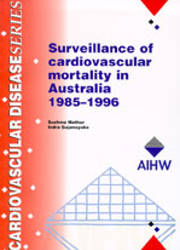Summary
This report on surveillance of cardiovascular disease mortality, prepared within the National Centre for Monitoring Cardiovascular Disease, addresses one of the important functions of the monitoring system: to monitor and report on trends and differentials in cardiovascular mortality. It provides a detailed statistical profile of patterns and trends in cardiovascular disease mortality for Australia, each State and Territory, Indigenous and non-Indigenous people and people living in urban, rural and remote areas of Australia. The main findings of the report are:
Australia
Cardiovascular disease continues to be the leading cause of death in Australia, although death rates are falling in all ages for males and females.
- In 1996, cardiovascular disease accounted for 53,990 deaths or 42% of all deaths among Australians.
- Cardiovascular mortality has been declining over recent decades, with current annual rates of decline at 3.7% for males and 3.6% for females, over the period 1985–1996. The decline in cardiovascular mortality is more rapid than that for total mortality.
- Death rates from cardiovascular disease are declining in all age groups, but the decline is most rapid in the 45–59 age group (over 6% per year).
- Ischaemic heart disease remains the major cardiovascular cause of death (55% of such deaths), and is declining at a rate of 4% per year for males and 3.6% for females.
- If current trends continue, Australian death rates for premature mortality (25–74 years) from ischaemic heart disease will be very close to national targets for the year 2000.
States and Territories
Age-standardised death rates for cardiovascular disease vary between States and Territories within 20% of the national average. Death rates are falling in all States and Territories but more slowly in the Northern Territory. This slower rate of decline is attributed to the large proportion of Indigenous people in the Territory, among whom rates of decline in the 25–64 age group are considerably lower.
- Cardiovascular disease death rates are higher than the national average in the Northern Territory (20% higher in males and 15% higher in females) and in Tasmania (12% and 10%). Rates are lower than the national average in the Australian Capital Territory (8% lower in males) and Western Australia (6% in males and 7% in females).
- Rates of decline for cardiovascular disease are generally around 3% per year or more except for the Northern Territory where rates of decline are slower.
- Death rates for ischaemic heart disease are highest in Tasmania (9% higher than the national average for males and 5% for females) and Queensland (5% and 7% respectively). Death rates in the Northern Territory and the Australian Capital Territory are about 10% below the national average. Again, rates of decline are slower in the Northern Territory.
- Death rates from cerebrovascular disease are highest in the Northern Territory and Tasmania, and are declining in every State and Territory, except the Northern Territory, where mortality rates are increasing for males and females.
Indigenous people and other Australians
Indigenous people clearly experience greater death rates for cardiovascular disease than other Australians, but female death rates are falling in both populations.
- Cardiovascular disease death rates are six times higher for Indigenous males and nine times higher for Indigenous females for the 25–64 age group, compared with other Australians.
- The greatest difference in cardiovascular disease death rates between the Indigenous and non- Indigenous populations occurs in the younger age groups.
- Among the Indigenous population, cardiovascular mortality is declining at the rate of 5.2% for females over the period 1991–1996, while for males there is no change.
Urban, rural and remote areas
There have been no marked differentials in cardiovascular mortality between people living in the urban, rural and remote areas of Australia.
- Death rates from cardiovascular disease are slightly higher in rural and remote areas for males but not for females.
- Declines in cardiovascular mortality between 1986 and 1996 are comparable for urban, rural and remote areas.



